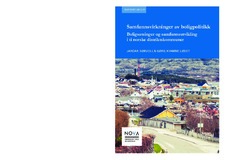| dc.description.abstract | In this report, we analyse the societal effects of housing policy strategies in small and rural Norwegian municipalities. The following research questions are discussed on the empirical basis of municipal planning documents, interviews with ten informants from ten municipalities, and an internet survey answered by 20 local government employees: Rural housing markets. To what extent do housing policy strategies contribute to more well-functioning housing markets? Housing markets in rural municipalities are sometimes described as small, risky and stagnating (Nygaard 2012) – meaning that they for instance are characterized by single-family housing, few rental units, little or no new construction, very limited number of yearly property transactions and a risk of losing significant amounts of money on property investments. The national government and some rural municipalities have sought to address and alleviate these problems through various housing policy strategies, such as promoting rental housing through cooperation with firms in the private sector, or promoting new construction through economic incentives to individuals or construction companies. Housing policy and attractive municipalities. To what extent do housing policy strategies foster population growth? Housing policy and business. To what extent do housing policy strategies contribute to making rural municipalities more attractive for businesses? Housing policy and public health. To what extent do housing policy strategies contribute to improving public health? Housing policy and public services. To what extent do housing policy strategies foster efficiency and quality in public services? In this report, we use elder care as an example when pondering this question. Housing policy and inclusion. To what extent do housing policy strategies contribute to the inclusion of immigrants and refugees on the housing market and the wider society? Housing policy, knowledge and skills. To what extent do housing policy strategies enhance knowledge and practical skills in rural municipalities? Challenges and policy relevance. What are the main challenges for rural municipalities executing housing policy strategies? The housing policy strategies in the ten municipalities analysed in this study may be described with the aid of Vedung’s parsimonious typology of policy instruments. The Swedish political scientist distinguishes between carrots, sticks and sermons. Sticks are regulations that command actors to behave in a certain way. Carrots are economic incentives designed to promote or prevent actions. Sermons are acts of communication that try to influence actors to act in ways thought beneficial or abstain from acting in ways deemed harmful (Vedung 2007). All of the municipalities studied use a combination of policy instruments that are covered by this threefold typology. They use carrots in the form of economic incentives to individuals and/or construction companies, sticks in the form of mandatory building and area regulations, and sermons in the form of communication about the alleged benefits and opportunities of their local housing markets. The housing policy strategies pursued in the ten municipalities studied have had some positive effects, for instance for the functioning of housing markets, local business activity, public health, elder care, the inclusion of immigrants and refugees in housing markets and (perhaps) wider society. However, more in-depth case studies are needed to more accurately measure the impact of housing policy strategies in rural Norwegian municipalities. The study also highlights some important challenges for rural municipalities executing housing policy strategies. For instance, economic funds provided by the national government through programs targeting rural municipalities, have been important for the promotion of housing construction in many of the ten municipalities analysed. In some municipalities, it has proven difficult to persuade individuals or companies to build new housing units without economic incentives. The current lack of targeted national funds may therefore be an obstacle for successful housing policy strategies in rural municipalities. On the other hand, Hamarøy – one of the municipalities covered by this study – have managed to advance new construction through the regular economic policy instruments of the Norwegian state’s Housing Bank. This underscores that these economic policy instruments – already in place – may contribute decisively to the construction of housing in rural areas. In the future, a feasible strategy for the national government could be to adapt the Housing Bank’s economic instruments even more closely to the needs of the housing markets in rural Norway. | en |
| dc.description.abstract | Boligtilbudet i distriktene kan være dårlig tilpasset ulike grupper som ungdom, eldre eller arbeidsinnvandrere. Lav omsetningsaktivitet, lite nybygging, begrenset variasjon og høy risiko kjennetegner slike boligmarkeder. Blant annet derfor gjennomfører noen norske distriktskommuner boligpolitiske satsinger med sikte på å bidra til mer velfungerende markeder. I denne rapporten diskuterer vi samfunnsvirkningene av boligsatsingene i ti norske distriktskommuner. Hva er satsingenes bidrag til den lokale samfunnsutviklingen, for eksempel med tanke på bostedsattraktivitet, næringsattraktivitet og inkludering av ulike grupper? I rapporten forsøker vi å besvare dette spørsmålet ved hjelp av kvalitative intervjuer, dokumentstudier og en internettsurvey. | no_NB |
